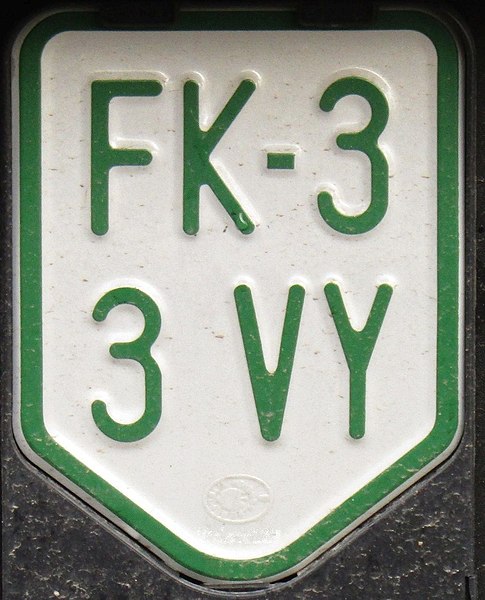European vehicle registration plate
A vehicle registration plate, also known as a number plate, license plate or licence plate, is a metal or plastic plate or plates attached to a motor vehicle or trailer for official identification purposes. The registration identifier is a numeric or alphanumeric code that uniquely identifies the vehicle within the issuing authority's database. In Europe most countries have adopted a format for registration plates that satisfies the requirements in the Vienna Convention on Road Traffic, which states that cross-border vehicles must display a distinguishing code for the country of registration on the rear of the vehicle. This sign may be an oval sticker placed separately from the registration plate, or may be incorporated into the plate. When the distinguishing sign is incorporated into the registration plate, it must also appear on the front plate of the vehicle, and may be supplemented with the flag or emblem of the national state, or the emblem of the regional economic integration organisation to which the country belongs. An example of such format is the common EU format, with the EU flag above the country code issued in EU member states.

Image: Andorra motorcycle plate
Image: Plate motorcycle Austria PL 1YEX
Image: Austria moped plate
Image: Electric motorcycle license plate Austria (Feldkirch)
Vehicle registration plate
A vehicle registration plate, also known as a number plate or license plate or licence plate, is a metal or plastic plate attached to a motor vehicle or trailer for official identification purposes. All countries require registration plates for road vehicles such as cars, trucks, and motorcycles. Whether they are required for other vehicles, such as bicycles, boats, or tractors, may vary by jurisdiction. The registration identifier is a numeric or alphanumeric ID that uniquely identifies the vehicle or vehicle owner within the issuing region's vehicle register. In some countries, the identifier is unique within the entire country, while in others it is unique within a state or province. Whether the identifier is associated with a vehicle or a person also varies by issuing agency. There are also electronic license plates.
Some jurisdictions license non-traditional vehicles, such as golf carts, particularly on-road vehicles, such as this one in Put-in-Bay, Ohio.
Two Swedish snowmobiles with license plates attached to the side of the vehicles
The damage to the enamel on this Wyoming license plate from 1916 exposed the iron, causing it to rust.
In 1944, Wyoming license plates were made of soybean-based fiberboard due to metal conservation for World War II.








